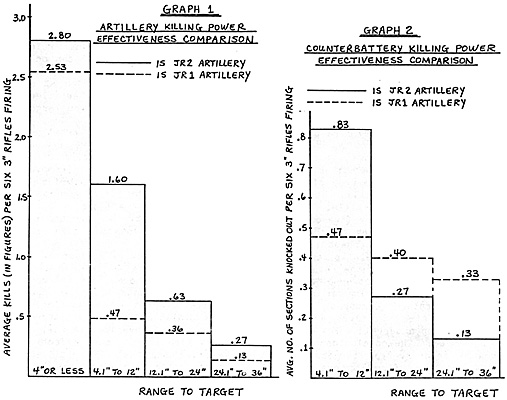As with the revision of any set of popular wargame rules, I looked upon the release of the 2nd Edition of "Johnny Reb" by Game Designers' Workshop with both enthusiasm and skepticism. Since I had used the original edition of JR (JR1) since it hit the hobby shop shelves and had grown quite fond of them, I was very concerned about what someone COULD do to my favorite set of miniatures rules. Well, after two battles under my belt with the new 2nd edition (JR2), I'm happy to say that most of my Initial fears have been laid to rest. JR2 is still much the same as JR1, but the area of greatest difference is with artillery fire resolution and effectiveness.
The artillery fire resolution procedure has undergone a radical overhaul for JR2. Each section of guns is now worth a certain number of fire factors at the various range increments shown on Table 13. Batteries can now issue "battery fire" in which the effect of the entire battery's fire is determined by adding up the fire factors of the battery's sections, checking Table 14 for appropriate modifiers and rolling a single pair of dice once and consulting Tables 10 and 11 to determine how many casualties are produced on the final fire factor line. Sections can still fire individually as in JR1 if they so desire, but this option would almost certainly always result in less effective fire.
Artillery can now become "out of ammo" with a fire resolution die roll sum of 2, in a similar manner as with infantry small arms fire, and is particularly painful when using battery fire. Exploding Parrott rifles are now covered by an optional rule. Canister and double-canister range for all guns is now 411, but gunners can only issue double-canister fire if they first take a fear-of-charge morale check and do not rout (this check is mandatory even if the gunners are not the target of the charging enemy). Each kill caused by artillery necessitates a "artillery hit" morale check (up to a maximum of three per turn) to be taken by the target unit.
The counter-battery fire procedure has also been greatly modified. Artillery fire is classified now as "shot" or "canister", with canister fire possibly eliminating enemy crewmen and shot fire possibly eliminating an entire enemy section per hit. If a battery is hit by shot, it gets a chance to save (remove) the kill based on the type of gun (Whitworth, rifle or smoothbore) that issued the shot. Smoothbore kills are the easiest to save, followed by rifled gun kills and then by Whitworth kills. Our second battle with JR2 showed all too well the awesome counter-battery fire capabilities of the 20 lb. Parrott. We were shocked when a six gun battery of these rifles destroyed three sections of unlimbered enemy guns in one fire phase at a range of under 24"!
I have made a statistical analysis of the artillery fire effectiveness of both JR1 and JR2, and the results are shown on the accompanying graphs. Graph 1 compares the killing power of a battery of six 3" rifles (avg. crew, did not move during the turn) firing at an advancing formed enemy infantry line in open ground. Graph 2 compares the counter-battery effectiveness of a stationary battery of six 3" rifles (avg. crew) firing at a stationary enemy unlimbered battery in open terrain. For each of the two examined cases, average die rolling was assumed. The conclusions are that JR2 artillery fire is much more effective against infantry-type targets at all range categories and that JR1 artillery counter-battery fire is more effective at all range categories except at less than 2211, where JR2 is substantially more effective.
It appears that the artillerist's day has indeed arrived at last with the advent of JR2. Artillery's effect can be quite devastating on the JR2 battlefield, and an attacker can now find his force mauled in a previously unprecedented fashion if he doesn't advance in a careful, calculated manner with an appropriate screen of protective skirmishers out in front of his main body of troops. Conversely, the new potent artillery fire now allows the attacker who can effectively concentrate his guns a chance to soften up the defender's position before his assault is launched. Only time and experience will allow us to pass proper judgement on the artillery revisions found in JR2. I personally feel that the increased artillery effectiveness of JR2 is more historically accurate, and I like the fact that the playing of the game is both easier and much faster with the new streamlined firing procedure.

Back to The Zouave Vol II No. 2 Table of Contents
Back to The Zouave List of Issues
Back to Master Magazine List
© Copyright 1988 The American Civil War Society
This article appears in MagWeb (Magazine Web) on the Internet World Wide Web.
Other military history articles and gaming articles are available at http://www.magweb.com